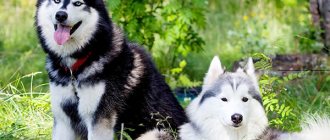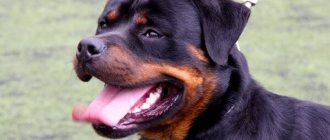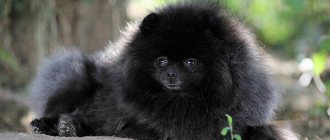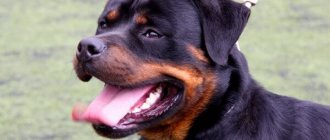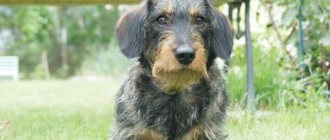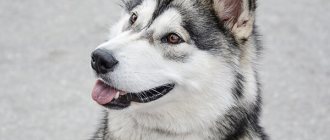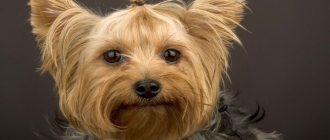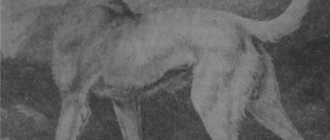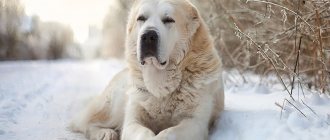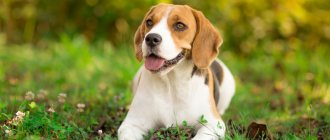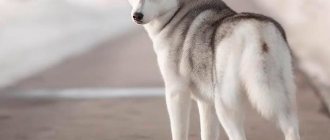Alabai, or, as it is more correct to call a representative of this breed, the Central Asian Shepherd Dog (SAO) is a large, brave, strong dog with a developed innate instinct of a hunter and guard.
Alabais rank 8th among the largest dogs in the world.
Despite their impressive size and menacing appearance, these beautiful animals look very harmonious and even graceful in appearance.
However, the restrained power, which cannot be overlooked in the alabai, inspires respect and even fear.
This article presents the types of the Alabai breed with their names, descriptions and photographs.
Breed standard
Central Asian Shepherds are large, well-proportioned dogs with well-developed muscles hidden under fairly thick skin.
An adult male of this breed grows at the withers to at least 70 cm and weighs at least 50 kg, and an adult female reaches a height of at least 62-65 cm with a body weight of 40 kg.
NOTE!
Due to sudden outbursts of aggression, these animals are listed as dangerous breeds in Russia and Ukraine and are banned in Denmark.
To meet the breed standard , Alabais must have:
- strong, muscular body with developed bones;
- wide chest, rounded ribs;
- straight back;
- wide and short loin;
- toned stomach;
- short neck with developed muscles;
- massive, wide head, almost rectangular in format;
- pronounced brow ridges;
- the forehead is wide and flat, the stop is not clearly expressed;
- the nose is straight, large black or brown;
- the eyes are round, set far apart, the iris is dark;
- scissor bite;
- paws are straight, long, muscular;
- ears are small, triangular, hanging;
- the tail is thick, saber-shaped, set low.
Alabai can be undocked , with ears and a tail of natural length, but in countries where docking is not prohibited by law, this procedure is traditionally carried out.
History of the Central Asian Shepherd Dog
The nomadic way of life of the peoples of Asia in ancient times, their defenselessness against wild predators formed a set of requirements, possessing which the dog actually became a universal helper and protector.
Protection was required not only for people, but also for their households. Central Asian Shepherd Dogs fully met these requirements.
At that time, the Alabai breed was just beginning to take shape. But people could rely on these strong and reliable dogs with complete confidence...
Photo 3. Handsome Alabai
People kept the dogs that showed the least aggression, the most obedient and at the same time the strongest and strongest.
Already several thousand years ago, such unique breeding work gradually formed a breed that became a true symbol of reliability.
Many khans of that time deliberately bred dogs, understanding the importance of having such helpers.
Since such a “folk” selection of the best qualities of dogs was carried out everywhere, the breed had several names: Turkmen wolfhound, Alabai and a number of others, even deeply dialectal ones.
The official name of the breed (as written in the standard) is Central Asian Shepherd Dog .
In Russia (at that time - the USSR), the breed began its march in the first half of the 20th century, and its closest relatives are the Caucasian Shepherd Dog, Spanish Mastiff, Mongolian Shepherd Dog and a number of other dog breeds.
The size of a dog compared to a person
A comparison of the size of the Central Asian Shepherd Dog next to a person can be shown by its height at the withers or when it stands on its hind legs.
Thus, the average height of adult Alabais at the withers is at least 70, and more often 80 cm, which indicates that the head of a pet of this size will be almost at the level of the knees of a person of average height.
Standing on their hind legs, these dogs can be the same height as their owner or even taller.
So, when the largest, in fact, even huge, Alabai in the territory of the former USSR, nicknamed Bulldozer , stood on its hind legs, its height was about 2 m, which exceeded the height of its owner.
Health
Central Asian Shepherds are distinguished by good health. But errors in maintenance and feeding harm the dog.
Lack of exercise leads to obesity, and improper feeding leads to diabetes.
In addition, Alabai are prone to diseases of the musculoskeletal system and cardiovascular system.
If raised incorrectly, they suffer from neurosis.
Character and temperament
Alabais are distinguished by calmness, self-confidence, balanced character and stable psyche. These are proud and independent animals, accustomed to making their own decisions and capable of obeying only those who prove their unconditional leadership.
Representatives of this breed have a developed territorial instinct, so they are wary and even aggressive towards strangers. These are brave, strong dogs who, if they sense that they or their family are in danger, will not hesitate to rush at the offender, even if he is larger.
Central Asian Shepherds are smart animals, they remember commands quite quickly and understand perfectly well what their owner wants from them. However, their inherent stubbornness, independence, predominance of protective instincts and tendency to dominate complicate the training process.
IMPORTANT!
Without proper training and early socialization, these dogs grow up uncontrollable and aggressive.
They can get along with other pets only after they have proven their leadership to them, which means that skirmishes and fights are almost inevitable at first. They will treat other people's animals with indifference only if they are properly and timely socialized; otherwise, all cats, birds, rodents and even dogs will be perceived by Alabai only as objects of hunting.
It is better not to have representatives of this breed in families with children under at least 6-7 years of age. Alabais are quite patient with children, but only if they respect their personal boundaries, which should not be expected from children. In addition, a large dog can accidentally startle, push or injure a child.
Training
Alabai need to be raised from three months of age, devoting at least 20 minutes a day to this process. All family members should take part in the process of education, and only one should feed - the owner of the shepherd dog. You can train a dog at home, but it is better to contact an instructor. A nine month old puppy should know and follow basic commands. If a small Alabaik, while playing, tries to bite the legs, arms or clothes, this must be stopped, but you should not wave it away, scream or run away. The baby will perceive this behavior as a game. You should freeze in place, firmly say the command fu and leave. Do not allow the dog to dominate; you should be affectionate, but strict. If a task has been given, it is necessary to ensure its precise implementation.
Puppy training should be interesting. Also, we must not forget about encouragement - it can be not only a tasty morsel, but also affection and verbal approval. It is very important for Alabai to realize that the owner is happy with him. It is important to achieve the main thing - so that the dog calmly gives its owner its food. This will mean that the person is recognized by her as the main one. If a grown-up Alabai bites its owner, it means that it has not completed a competent training course and feels like the leader of the pack. If you raise him with excessive cruelty, aggression in adulthood will become a defensive reaction. It is very difficult to re-educate an Alabai. Therefore, those who do not have experience with dogs should not choose this breed.
During the training process, it is important to remember that Asians are very vindictive and touchy. Beating an animal is unacceptable; the maximum that can be done is to lightly hit the shepherd dog (while it is very small) on the nose with a rolled-up newspaper, but so that the movement is imperceptible.
You can't hit a dog with your hand! Alabai should not perceive the owner as an enemy.
Another aspect that should be given special attention is to teach calm communication with other dogs, without depriving the pet of such contacts. If everything is done correctly, then there is an opportunity to get a calm and devoted friend, a reliable security guard.
Photos of popular species and their descriptions
Alabai is a common dog breed, especially in Asian countries. And each of them has its own vision of the ideal representative of this breed. Additionally, the appearance of each breed variety varies depending on its natural habitat.
Tibetan
The Tibetan Alabai is a large, shaggy and muscular dog with harmonious proportions and a moderately elongated body. Males grow to at least 70 cm at the withers with a body weight of 50 kg, females are 65 cm tall and weigh 40 kg.
Turkmen
They are considered the descendants of Tibetan mastiffs, which, after entering Central Asia, began to acquire features characteristic of modern Alabai.
These are guard dogs, not fighting dogs, but they can fend for themselves and protect their owner. They have a tendency to dominate and can get along with other animals only if they recognize their leadership qualities.
Turkmen Alabai
are fierce and independent, but also loyal, self-confident and have a balanced character and stable psyche.
Caucasian Shepherd Dog
Caucasian Shepherd Dogs are freedom-loving animals that will not obey anyone except their owner, in whom they will see the leader and leader. They are much more aggressive and impetuous than the Turkmen Alabais.
They do not require special care and live an average of 14-15 years. Height at the withers is about 65-75 cm, and body weight is 50-75 kg. Most often these dogs are used for protection. Due to their high degree of aggressiveness, such dogs must be kept with the utmost care.
Turkish Kangal
Representatives of the Turkish Kangal breed have been used since ancient times as fighting dogs, protectors and hunters.
These are obedient dogs, distinguished by speed, courage, endurance, vigilance, distrust and the ability to make decisions independently, assessing the situation. They are kind and flexible and get along well with other animals.
Height at the withers reaches 70-80 cm, weight – 55-65 kg. The coat can be gray-yellow or gray-brown.
Kyrgyz wolfhound (debit)
The breed is on the verge of extinction.
These wolfhounds were used primarily for herding. These are large, powerful animals with thick and straight hair; they can be either short- or long-haired. They have a calm character and are obedient. They grow up to 70-76 cm at the withers and weigh 40-70 kg.
Uzbek buribasar
Compared to other varieties of Alabai, the Uzbek Buribasar has a miniature stature, an elongated body and an elongated muzzle.
Smart, flexible, reserved dogs.
Kazakh tobet
Strong, hardy, large animals, reaching a height of 77 cm and a weight of about 45-65 kg. The coat is coarse and thick, piebald or spotted color is acceptable. They get along well with other animals and have a good guard instinct.
At the moment, the species is on the verge of extinction.
Siberian
The Siberian Alabai is a cross between a German Shepherd and a Siberian Husky. A large dog with thick fur. Characterized by a high level of intelligence, sociability, obedience and developed security and protective instincts.
Tajik
These dogs are larger than the Turkmen Alabay, have a heavier shape and resemble St. Bernards. Good-natured and reserved animals, good shepherds and loyal friends.
Alaskan Malamute)
There are 2 types of Malamutes: Kotzebue (with a wolf-colored coat) and M'Lut (coat of black and white, sable and white, white and blue). They grow up to 77 cm at the withers and weigh 55 kg. Friendly, intelligent, but sometimes overly stubborn dogs.
Armenian (Gampr)
These are viable, independent, self-sufficient dogs with short or long coats. Height is 65-78 cm, weight is approximately 60 kg.
Alabai from Afghanistan
One of the oldest dogs with a refined body, up to 75 cm tall and weighing 30-45 kg. Wool can be black, white, red, blue and other colors. Willful animals with a tendency to dominate.
Nutrition
Feeding such a large breed of dog must be taken very seriously.
- The main thing in the diet should be meat. It should be low-fat and the fresher the better.
- It is possible to use high quality ready-made feed. You should not feed your Asian dog dry food intended for small dogs.
- For Asians, sweets, flour, spices, and, of course, salty are forbidden.
- Porridge and fish, but low-fat, are very good. Vegetables and fruits will also come in handy in your dog’s diet. Eggs, dairy products.
A balanced diet, which contains the vitamins and minerals necessary for the development of the Alabai, in combination with the correct dosage of portions, is the basis for the dog’s health and active life, as well as the prevention of many shepherd diseases.
Clean water should always be available.
Photos and descriptions of colors
The Alabai coat can be not only white or black and white, there are many possible variations of its color.
White
There are no albinos among the Alabais, even in the absence of a coloring pigment in the coat of these dogs, which is why it looks snow-white; the lips, nose and eyelids of the Alabais are colored black or brown.
Ginger
Red fur can have many shades: yellow-golden, fawn, light beige, reddish-red and copper-brown. The coat may be solid red or have white markings on the chest, belly, paws and face.
Dogs with a color called wolf look especially attractive: the main color of their coat is bright red or has a gray-brown tint, the hairs on the stomach, neck and chest are white, and the lower part of the forehead, cheeks and area around the eyes are black or dark -gray.
Black
The coat can be solid black or have dark brown, white or red spots.
The most common coat color of Alabais is a combination of black and white. If the main color of the coat is white, then black spots are located on the back, hind legs and top of the dogs head. In the case when the fur is black, the belly, chest and lower part of the paws of the Alabai are painted white.
brindle
The tiger alabai is the owner of wool, the color of which is combined with gray, brown or yellowish-golden colors. On the back, neck, croup and limbs there are dark stripes located transversely and closing into rings on the chest and belly.
Many individuals with this color have almost black fur on their faces, making it appear as if they are wearing masks.
Brown
Brown coat color varies from pure brown to brown.
NOTE!
In accordance with the standard, silver-blue and chocolate coat colors are considered unacceptable - it is believed that coat of such colors is characteristic of dogs that are a cross between an Alabai and a Great Dane or a German Shepherd.
Grooming
When keeping an Alabai, you need to make it a rule and constantly examine the dog’s mouth, ears and eyes. Wipe your eyes with a cotton swab dipped in tea leaves. Treat the ears with a cotton swab soaked in chlorhexidine.
It will be enough to bathe the animal once a month, drying the fur well.
Constantly comb, and especially during the molting period. The bedding where the dog sleeps can be washed more often.
Smooth-haired and long-haired dogs
Central Asian Shepherd Dogs have a coat consisting of 3 layers: dense undercoat, outer coat, and guard hairs. The hairs are thick and hard, dense and erect.
The area of natural residence of the Alabai affects their appearance, including the length of their coat. Depending on the length of the hairs, Alabai are divided into two types - long-haired and smooth-haired.
Longhair
Alabais living in mountainous areas are more massive, their subcutaneous fatty tissue is better developed, and the outer hair of such dogs is longer - 7-10 cm, fluffy. They have a well-developed mane and decorative hair on the withers, behind the ears, in the riding breeches and on the back of the tail.
Thanks to their low center of gravity, these dogs can maintain balance during mountain treks. They have a balanced nervous system, a well-developed vestibular apparatus and do not need constant contact with humans.
Long-haired Alabai do not require an insulated enclosure in winter; they tolerate any frost well.
The long-haired Central Asian dog is common in Turkmenistan, but it has not yet been recognized as an independent breed; officially it is a mongrel.
Smooth-haired
Dogs living in steppe regions have lighter bones and higher legs, they are more mobile and have a smooth (3-5 cm in length) coat. The short-haired Alabai has a more active psyche, it is more sociable and easier to train.
Their coat is uniform throughout the body, shortened on the front side of the paws and slightly lengthened at the withers.
Feeding
Central Asian Shepherds do not eat as much as they might seem. Feeding a pet comes down to creating a diet “according to needs.” It is important to understand that, given the high energy content, food should not contain large amounts of carbohydrates (especially for young dogs). Diet adjustments are made by monitoring weight gain; obesity is an extremely undesirable disease that has a detrimental effect on the dog’s joints and heart.
The best option is natural feeding , that is, meat, cereals, vegetables and fruits. Usually, Asians are given moslaks, but not as food, but as a toy. Fish is not that important, but ocean varieties are rich in trace elements and essential amino acids. Dairy products are useful, provided that the dog itself wants to consume them and does not experience stomach upset afterwards.
Important! It is necessary to regularly include vitamin supplements in the natural diet.
Feed can be considered as an alternative. Naturally, the products should be designed for large and fast-growing breeds. Until the age of 3, the pet should receive food with a strengthened composition. Product class is not lower than premium, for puppies and old dogs, not lower than super-premium.
Mini-Alabai - a defect or a separate breed?
Central Asian Shepherds that have not reached the height at the withers established by the standard (the so-called mini) are considered a defective breed.
Such deviations can arise as a result of genetic changes, interbreed mating, the purpose of which was to produce smaller dogs, or as a result of a lack in the puppy’s body of vitamins, macro- and microelements necessary for proper and healthy growth and development.
However, small representatives of the breed, which are quite suitable for keeping even in city apartments, are in demand among those who like Central Asian Shepherds, but a number of reasons do not allow them to have such a pet.
IMPORTANT!
As a rule, a small (dwarf) representative of the breed, in addition to stunting, has other deviations in appearance and health problems.
Peculiarities of raising a Central Asian Shepherd Dog
Alabais are very smart, distinguished by perseverance and independence. Raising such a pet needs to be done from an early puppyhood, when the Alabai makes contact with its owner with great joy.
On the part of the owner, it is necessary to show patience and perseverance towards the “trainee”. The owner should not “give up” and show uncertainty in his own actions.
If an “Asian” finds an Achilles heel in your character, he will immediately take advantage of it.
Photo 6. Alabai demands respect
Having matured and become wiser, such a dog, out of reluctance to carry out certain commands, can, for example, pretend to be sick and weak. And this is no joke.
The goal that the owner of the Alabai should set for himself when raising him is complete unquestioning obedience and execution of commands.
Otherwise, in various situations, it will simply be impossible to cope with him and pull him away from another dog.
A loyal attitude towards other four-legged animals is the second important goal that the owner of a Central Asian Shepherd dog must achieve when raising.
If you can control the Alabai’s outbursts of aggression towards other dogs, you will avoid a lot of problems and troubles.
It is possible to achieve results in achieving such goals only by accustoming the Alabai from childhood to walks in places where representatives of other breeds can be found, and also by not forgetting to punish the pet if it unreasonably shows aggression towards another dog.
Video about the Alabai (Central Asian Shepherd) dog breed:
Are boys different from girls?
During the first 6 months of life, the exterior of Alabai dogs is identical in males and females, and it is impossible to determine the gender of a puppy just by looking at it.
When dogs reach the age of 9-10 months, their exterior differences are already pronounced. The male's height at the withers reaches 80 cm, he weighs about 70 kg and has a massive overweight body and a bear-like large head. the girl, in turn, has a more graceful silhouette, she grows up to 70 cm at the withers and weighs 60 kg.
How to choose a puppy?
Before buying an Alabai puppy , you need to find out from the breeder the age of the bitch and the size of the litter. So, if the bitch is older than 8 years old or more than 5 puppies were born in the litter, then the likelihood of them developing serious diseases increases significantly.
It is also necessary to examine the puppy - if the Alabai is purebred and healthy, it has:
- smooth, “plush”, shiny coat without dandruff and bald patches;
- clean skin without rashes and inflammations;
- scissor bite;
- pink mucous membranes;
- clear eyes without signs of souring and increased lacrimation;
- clean ears without unpleasant odor or discharge.
NOTE!
In addition, the puppy should not have a bloated belly, excess weight or, on the contrary, signs of exhaustion or parasites. He should be active, playful and inquisitive.
